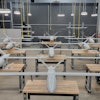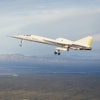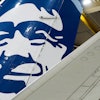In the not-too-distant future, airplanes will scythe into the wind with an airframe that can virtually streamline its shape using nothing but air. In pursuit of this goal, researchers at NASA and Boeing moved a vertical tail from an old 757 inside the world’s largest wind tunnel at NASA Ames Research Center in California to test technology called active flow control. Active flow uses tiny air jets to reduce friction and turbulence across flight surfaces.
The idea is definitely in the air. Last summer, Austrian mathematician Martin Hairer received a Fields Medal, considered to be math’s equivalent of the Nobel Prize, for his study of the flow of air around aircraft wings.
The NASA and Boeing teams outfitted the tail with a technology called sweeping jet actuators, which are devices with no moving parts that pump pressurized air across the tail. Just like dimples on golf balls, the actuators create a thin, turbulent layer of air that helps “reattach” air flows to the surface and make flight more efficient.
Once refined, the technology could allow aircraft designers to make smaller and lighter tails that produce less drag, which could translate into more efficient flight, lower fuel burn and save airlines millions of dollars. Boeing plans to conduct flight tests in 2015.
Scientists at GE’s Global Research Center have separately been studying active flow control for aviation and to improve wind turbines’ ability to convert wind into electricity. The GE scientists are using a technology called synthetic jet actuators, or SJAs, which have no moving parts but use tiny amounts of energy to breathe in and pump out air jets through small holes along a wing or blade’s surface.
SJAs speed up air that naturally slows as it flows over the surface due to friction. “By expanding and contracting a chamber such that air is sucked in and ejected through a single hole, this device works similar to a human lung,” says Seyed Saddoughi, principal engineer in Aero-Thermal & Mechanical Systems, who is leading the actuator’s development. “The advantage is that there is no need for pumps that use external flow, or fans with moving parts. The device is lightweight and very simple in operation, with minimal power usage.”
The actuators pump air efficiently by applying an alternating current to two parallel plates separated by a slight space. Employing a phenomenon called the piezoelectric effect, the two plates bend and straighten as electricity moves through them, causing the middle chamber to rapidly pull in and push out air. GE has already licensed the technology to cool consumer electronics and computers, where it will replace bulkier fans that need more energy and space.
Saddoughi’s research team has also been experimenting on another version of the technology that can operate in water. Their experiments have shown that pumping high-powered water jets against the surface of boat hulls can change hydrodynamic flow and decrease drag.
“Synthetic jet actuators give us active control of flow over these surfaces,” he says. “We can manipulate flow intelligently to gain better performance from our machines.”






















